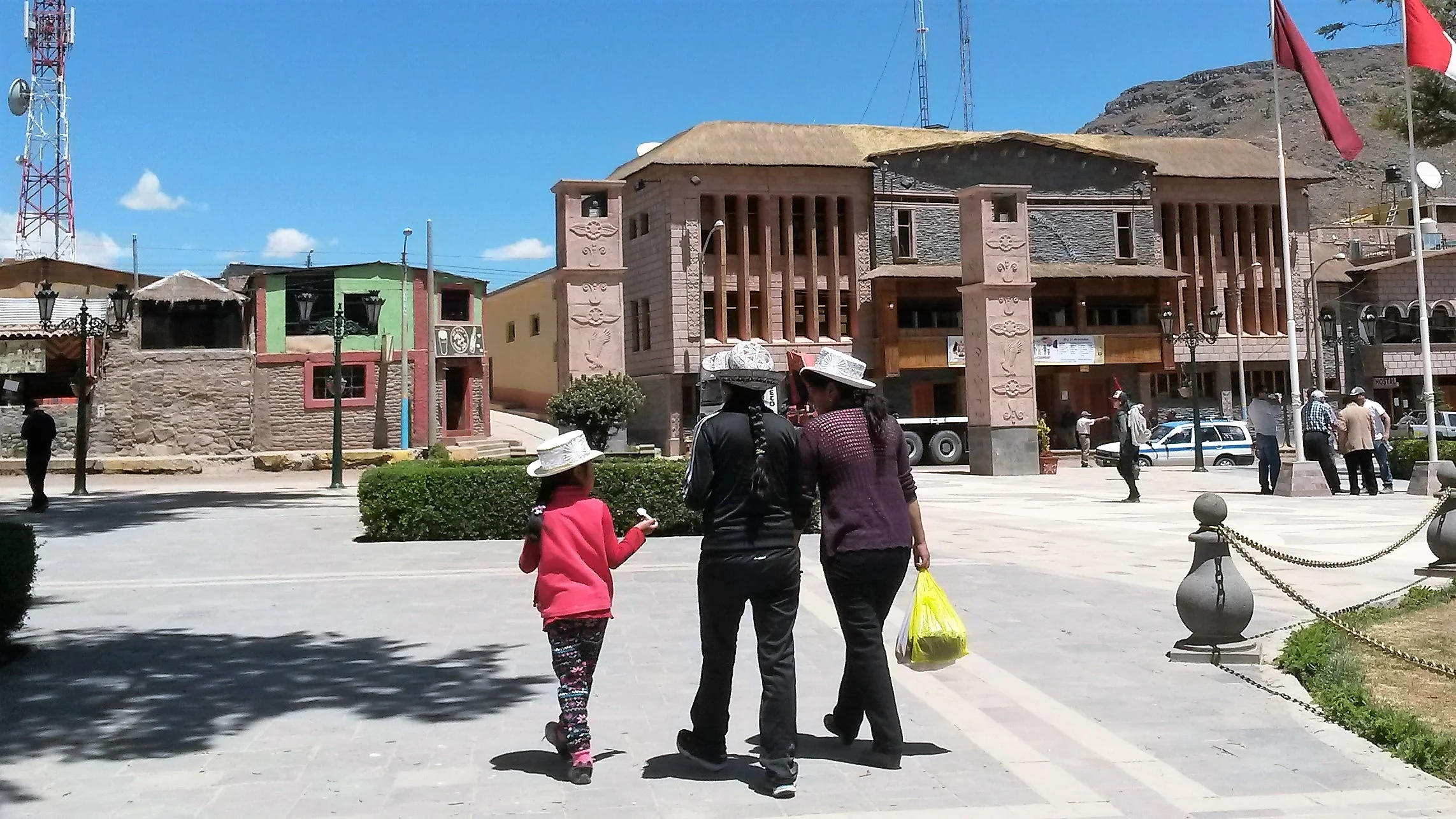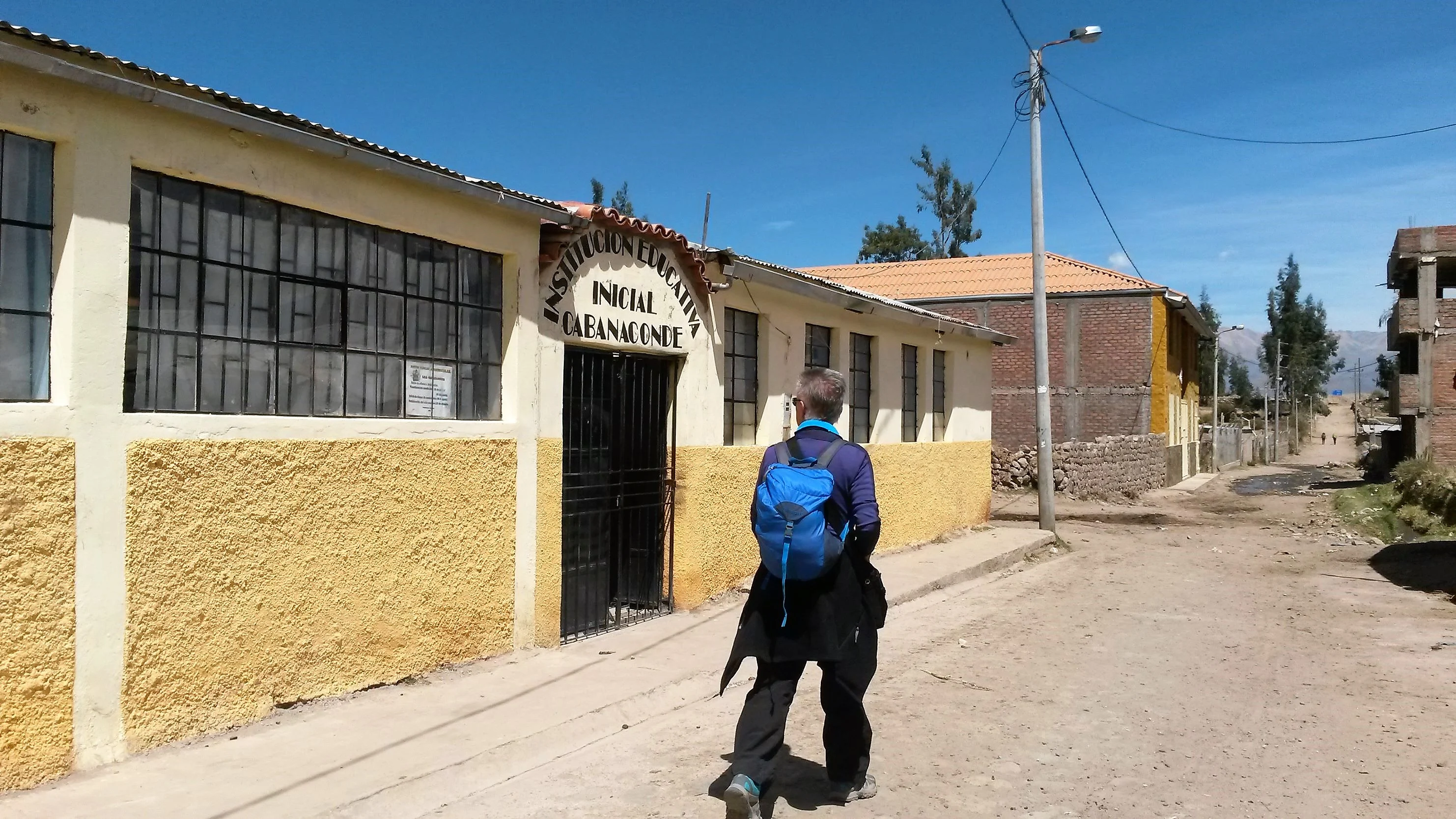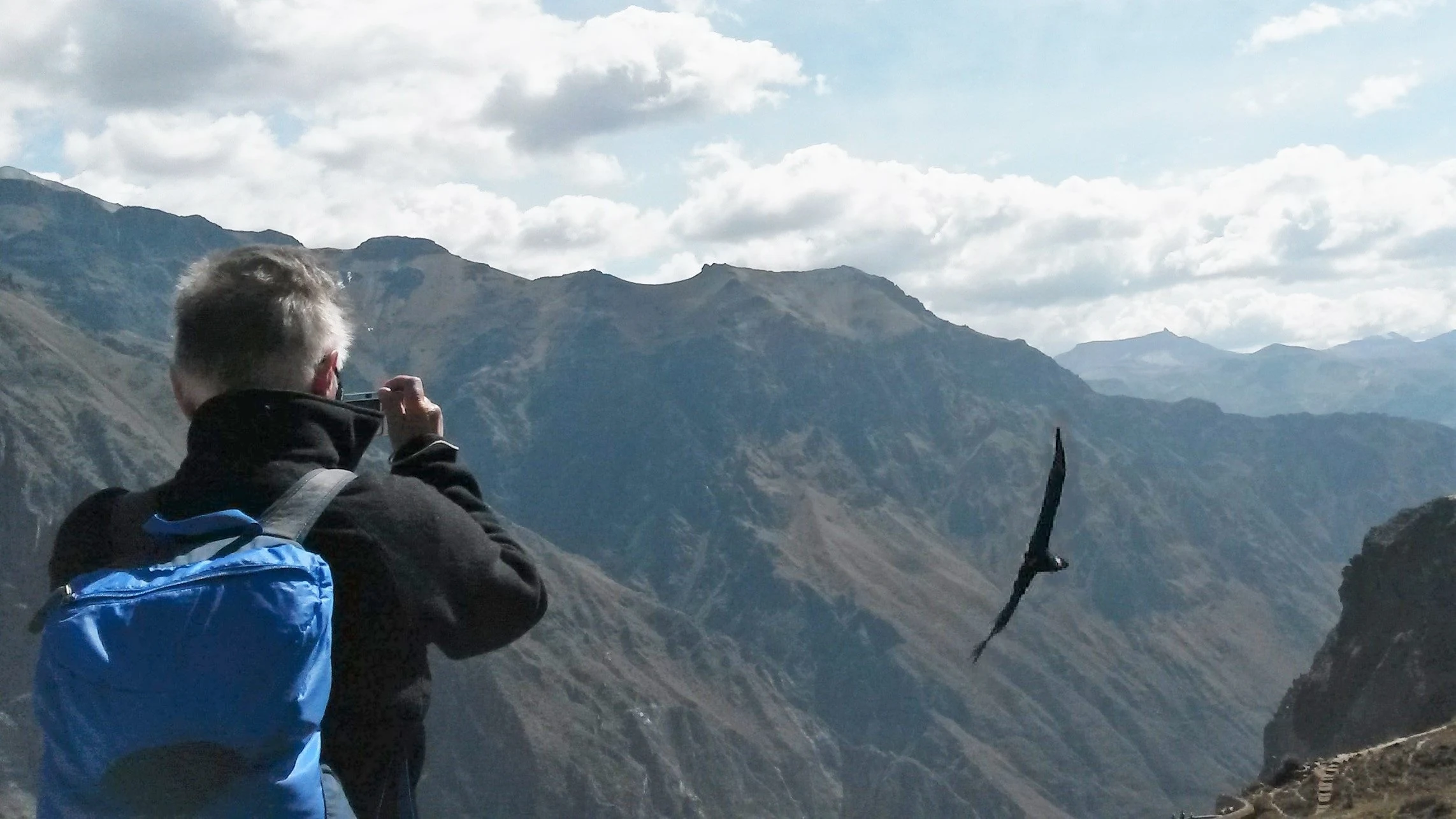After a fabulous week in Cusco and Machu Picchu, we were headed to Peru's Colca Canyon. It is one of the deepest canyons in the world, home to the giant Andean Condor, and contains remote traditional villages whose residents farm on agricultural terraces that predate the Incas.
This amazing canyon is in southern Peru, south of Cusco. It is huge, at
between 1,000 and 2,000 metres deep, with rims up to 4,000 metres above sea level, and a length of around 70 kilometres.
Looking forward to seeing this giant, we looked for a bus to take us from Cusco to Chivay, the gateway to the Colca Canyon.
But finding the right bus was a mission. We discovered that only tourist buses go to the canyon for sightseeing and roundtrips, but no public buses. Eventually a local travel agent organised a bus that would drop us off at the turnoff to Chivay and the canyon, advising us that we would have to find our way from there.
 |
| A village en-route to Chivay, Colca Canyon, Peru |
The next day, after a 6:30 am start, we caught a local Flores Line bus which rapidly filled with locals. The journey was interesting, with lots of drop offs and pickups in small villages along the way.
Ten hours later, our bus stopped at a service station just past the Chivay/Canyon turnoff. We disembarked, asked for directions in our inadequate Spanish, and were directed to a very bleak-looking corner where we could pick up a local bus or taxi to Chivay, a further two hours away.
 |
| Our windy bus stop at the turnoff to the Colca Canyon, Peru |
So we walked back the 150 metres or so to the Chivay/Canyon turnoff. It was the most windy and exposed place to
wait. We felt we were in the middle of nowhere stranded with no transport.
We waited for half an hour, which seemed a long time when you don't really know what or who you are waiting for. Then a rather decrepit bus hove into view. We waved him down and yes, he went to
Chivay. Yay….. But, the only free seats were the bumpiest ones, right at the back of the bus.
 |
| Scary road alongside the Colca Canyon, Peru |
While grateful for the seat, we
felt every bump and sway as the driver raced around the very winding and narrow (albeit
scenic) road on the edge of the Colca Canyon. Eventually, white knuckled from gripping the seats, we made it to Chivay located 3,650 m above sea level.
From the bus stop, it was a short walk around the corner to our
hotel, the Kollawas Home Inn, a B'nB run by a delightful woman called Marina.
She made us feel very welcome with a cup of tea and lots of local information.
 |
| Leigh in the main plaza of Chivay, Colca Valley, Peru |
Chivay is the biggest town in the Colca Valley with a population of around 5,000. It has an attractive town square, large market, hotels, and restaurants.
The local people are descendants of the
pre-Inca communities of Colagua and Cabana. These tribes used to differentiate themselves by deforming the heads of their children to either a flat or elongated shape, according to their local mountain god.
 |
| Cabana women in Chivay Plaza, Peru |
Now days, they differentiate using hats. We learned that the Colaguas use tall hats and the Cabanas have round flat ones. We saw some great hat variations as we wandered around, and many of those worn by women were beautifully embroidered.
That night, we found a nice restaurant in the town square for dinner, and enjoyed grilled alpaca with potatoes, a local speciality. While we were there, we saw lots of local people dancing through the square in what looked like, a parade.
 |
| Night parade in Chivay, Colca Valley, Peru |
They danced past us accompanied by men with strange musical instruments, which we found out later were harps with huge funnels on them. Harps are one of the traditional musical instruments of Peru.
We weren’t sure what the parade was about, but we suspect it was related to the season's harvest as this area is highly agricultural. It was
great to see their colourful outfits, swirling skirts, and laughing faces.
 |
| Life-like statues in Chivay, Colca Valley, Peru |
Many people here still wear traditional clothing, and there was a series of wonderfully colourful statues in one of Chivay's streets, showing the local clothing, dances, and activities. It is an interesting town.
After a few days in Chivay, we headed off to catch a bus for the 2-hour trip to Cabanaconde, the nearest village to the section of the Colca Canyon where the condors hunt.
 |
| Waiting for the late bus at the bus station, Chivay, Peru |
While we waited for the local bus, which was
running over 30 minutes late, we spotted our B'nB owner Marina. She and her father have
food stalls at the bus station. When the bus was late, she kept us informed and
made sure we got on the correct bus. A lovely woman.
The bus eventually showed up, and Leigh put
our cases into the bus boot. As she moved a small cardboard box, the box moved by itself, giving her the fright of her life. She peeked through holes in the box to find it full of
wee yellow chickens. Grinning hugely, she restored the box, secured the chickens and cases, and we headed off.
 |
| A very full bus of locals, and us two gringos, Colca Canyon, Peru |
The bus, full of locals with their produce and various bundles, seated, standing and sitting on the floor, wound its way through all of the tiny villages that dot the western side of the Canyon.
One of the villages was Yanque, built near the lip of the canyon at an altitude of 3,431 metres above sea level.
Its traditional town square is watched over by a beautiful white colonial church called Iglesia de la Inmaculada Concepción, that was built in 1560.
 |
| Villages en-route to Cabanaconde, Colca Canyon, Peru |
Leaving Yanque, our next village was Achoma, which has amazing agricultural terraces below it. We then arrived in the quiet village of Maca with its stone houses, then the village of Pinchollo.
The villages were all lovely, with donkeys as a key means of transport and people in traditional clothing. Buildings were mud-brick, with many colourfully painted and laid out around the town square, which was intersected by dusty earthen streets.
As we got closer to Cabanaconde, the road
disintegrated into a bumpy and rough ride - we reminded ourselves that there
had been a major earthquake with lots of damage here only a few months ago.
 |
| Pizza for dinner at Homestay Pachamama, Colca Canyon, Peru |
Arriving in Cabanaconde we dragged our bags up
the hill to Homestay Pachamama. This is a fairly basic hostel but we had a
private bathroom with a hot shower, and it also had a café with great pizzas which we enjoyed for dinner that night.
Cabanaconde has a population of under 3,000
consisting mainly of indigenous Cabana people. Sitting at the top of the canyon, it is at an altitude of 3,287 metres above sea level.
 |
| Local people celebrating in Cabanaconde, Colca Canyon, Peru |
We were walking around the village square one
night, when suddenly a group of Cabana people burst into view, dancing to a very energetic and noisy band. They danced around and around the square followed by lots of whooping men on horseback. We took photos but it
was dark. We’ve included some anyway.
Apparently, it was a celebration to ensure the crops yet to come, will be good and healthy. They do this in farm groups, so the crops should be great this year judging by the exuberant celebrations of this group!
 |
| A Chullcho dancer calling for a good crop in Cabanaconde, Colca Canyon, Peru |
The celebration seemed to go on for a long
time because we heard it during dinner back at the hostel, and after we went to
bed.
It felt like such a privilege to see this event and the one in Chivay, knowing that were they were not put on for tourists, but were the real thing.
The next morning, we were up early to catch the
7 am local bus to the Cruz del Condor, the best viewing platform to see the early morning flight of the condors.
As we were there so early, we got a good spot on the edge of the canyon and waited for the birds to appear. Suddenly, a condor was spotted gliding up out of the canyon's abyss in the misty morning sun. Great excitement!
The Andean Condor is the largest flying bird in the world with a wingspan of around 3.3 metres, a standing height of around 1.2 metres, and a weight up to 15 kg.
It is part of the vulture family so feeds on carrion. However, it is currently considered endangered due to lead poisoning in the carcases from the bullets used by hunters and farmers.
Many South American countries now have the condor as their national symbol. It is a majestic creature - this bird doesn't simply fly; it soars to great heights.
It was wonderful to see even one of these giants. However, several more soon appeared and they were at eye-level with us, gliding majestically on the thermals - how cool. What massive birds they are.
They slowly circled around the lookout rocks coming closer and closer giving us a wonderful display. One appeared to be going to land on a nearby rock
until a silly woman screeched and it flew away as everyone glared at her.
We had great views of the birds as some
flew right over us. It was a stunning display and we were very happy to have seen these amazing creatures.
After a while, the birds lost interest in us and flew off in search of food. But while we were at the look out, we walked around and had a closer look at the canyon.
 |
| The Colca Canyon and the Condor lookout |
Colca Canyon was known as the deepest canyon in the world, until the Cotahuasi Canyon just up the road a bit, was recently discovered to be around 170 metres deeper. Notwithstanding this, we were awed by the Colca.
This canyon is so deep that it has different climates at different levels. At the top you see potatoes and root vegetables being grown, but at the bottom there is a climate that supports the growth of tropical fruits.
 |
| Colca Canyon viewed from Mirador Achachiua, Peru |
Back in Cabanaconde later that day, we walked to the outskirts of town to Mirador Achachiua to get a different view of the canyon. There are several canyon miradors (lookouts) along the road between the villages and the views from each are slightly different, ranging from steep and rocky to gently sloping.
There are several day-walks that take you down into base of the canyon. However, we didn't do one, not trusting our legs to get us back up again!
 |
| Agricultural terraces along the Colca Canyon, Peru |
Along the edge of the canyon, there are some amazing agricultural terraces that date back to times before the Incas.
The Wari civilisation developed the concept of terracing before 1000 AD. They built stone walls along a slope and backfilled them with soil in order to make the steep land around the Andes Mountains more useable. The terraces help to prevent erosion, and retain water.
 |
| Agricultural terraces along the Colca Canyon, Peru |
Potatoes, maize and other similar crops have been grown in the shallow soils here ever since, and the locals still work the terraces using traditional methods.
A week later, it was time to move on. We headed to the bus stop in Cabanaconde and caught the local bus back through the villages to Chivay. We had to change buses there, so met up with Marina again. We were greeted like old friends - it was lovely.
 |
| Marg walking to the bus stop in Cabanaconde, Colca Canyon, Peru |
We bought bread rolls from her for our lunch, and while we waited for our bus, we ended up being on smiling and nodding terms with the bus stop locals. We found the them to be friendly and helpful people. Lots of them were very interested to know where we were from, and were amazed we were from so far away.
This was a lovely adventure, and trip to remember. We'd had no problems with the altitude, enjoyed the local food, and seen some awesome sights. But now we are moving on to catch a bus to Arequipa, the White City of Peru.
This is part of a blog series about our travels through the north-eastern countries of South America. The first blog in this series is called “In and around Santiago”.



